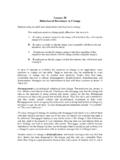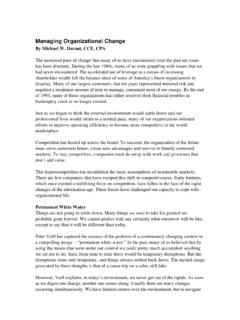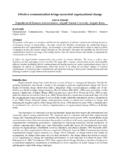Transcription of HIV The Basics Resistance 101: Interpreting and Using the Data
1 HIV The BasicsResistance 101: Interpreting and Using the DataSources: IAS - Resistance database - - of Drug Resistance Mutations in HIV:2009 Topics HIV :138-145 ACTHIV 2011: A State-of-the-Science Conference for Frontline Health ProfessionalsElizabeth Race, MD, MPHA cknowledgements:Joel E. Gallant, MD, MPHJ ohns Hopkins University School of MedicineBen J. Barnett, MDUniv. of Texas Health Science Center, HoustonObjectives At the conclusion of this presentation, listeners should be better able to: Identify the most clinically significant antiretroviral Resistance mutations associated with various classes of HIV drugs Select appropriate types of antiretroviral Resistance tests and implement these tests into their clinical practice to maximize successful patient outcomesOff-Label Disclosure: There will be no off-label/investigational uses discussed in this is Resistance & How Does It Occur?
2 The ability of HIV to multiply in the presence of suppressive level of antiretroviral drugs; Does notmake HIV more pathogenic Perhaps less pathogenic? Mutations may impair viral fitness. Can occur as primary transmission of resistant virus (TDR) Can occur with sub-suppressive levels of anti-viral drugs & then natural selection of mutant strains Partial adherence to regimen Sub-optimal dosing of drugs Drug interactions Incomplete absorption in intestinal tractHirsch. JAMA1998;279 Resistance is the Outcome of Viral Replication, Mutations & Selection PressureOriginal VirusQuasispeciesSelection Pressureexerted by DrugsHIV RNA LevelNew VirusQuasispeciesResistant cloneResistantclonesTimeHirsch. JAMA1998;279 Transmitted Drug Resistance : Newly Diagnosed 2007 CDC surveillance for TDR detected 16% of pts with new HIV diagnosis & mutations Most common: NNRTI 83% had single with TDR50% K103 NKim D, et al.
3 17th CROI; San Fran; February 16-19, 2010. Abst. 580; VianiR, et al. 13thCROI, Denver 2006; # Resistance in Young Pts: 55 recently infected pts (16-24 yo) from 15 US cities; approx. 50% AA; 25% GenotypeBy PhenotypeOverall18%22%NNRTI15%18% Testing: DHHS Guidelines Recommended in acute HIV infection Should be done for all pregnant women prior to therapy, or for those entering pregnancy with a detectable HIV VL on therapy In chronic infection, recommended for all patients on entry into care, regardless of treatment plan Perform when managing suboptimal VL decrease In the setting of viral failure, testing should be done while the patient is on therapy, or within 4 wks of stop Recommended to assist in selecting active drugs for pts with viral failure & VL> 1000; Consider in VL>500 Panel on Antiretroviral Guidelines for Adults and Adolescents. Guidelines for the use of antiretroviral agents in HIV-1-adults and adolescents.
4 DHHS. December 1, 2009; 1-161. Methods & Limitations of Resistance Testing Genotype: Direct sequencing of viral genes reverse transcriptase and protease, less commonly integraseand envelope Resistance to specific drugs is predictedbased on known mutations Mutations are detected only if mutant virus is at least 10-20% of virus population; minor variants can be missed Phenotype Grow virus in culture with various amounts of drugs added Direct measure of viral Resistance Does not explore the underlying mutations, just their affect on the ability of the drug to stop the virus Resistance tests are most accurate in assessing the current regimen; if Resistance has everbeen detected, then archived mutations exist If no drug pressure exists, wild type virus will often overgrow the mutant strainsAntiretroviral Guidelines for Adults and Adolescents. Guidelines for the use of antiretroviral agents in HIV-1-adults and , 2009; 1-161.
5 Genotypes Involve sequencing of various HIV genes and comparing results to reference wild type (wt) strain Primary mutations decrease drug susceptibility Example: M 184 V in Reverse Transcriptase (RT) 184refers to amino acid (AA) position 184in RT M (methionine )is the wt AA;V (valine) is the mutant Mixtures are when both wt and mutant AA s are detected: M 184 M/V Secondary mutations are selected after 1 mutations and may have a limited or cumulative effect Multi-Drug Resistance (MDR) mutations can decrease susc. to many or all drugs in a single classAntiretroviral Guidelines for Adults and Adolescents. Guidelines for the use of antiretroviral agents in HIV-1-adults and , 2009; 1-161. HIV Phenotype Phenotype refers to the growth characteristics virus in vitro; most useful for etravirineor PI s; also non-subtype B HIV Standard phenotypic testing Results usually expressed as fold-change in susceptibility compared to a laboratory control isolate Interpretation of drug activity dependent on methodology used to define cutoffs (clinical, biological, technical) Virtual phenotype testing Matches genotypic data against database of virus samples with paired GT and PT data Confidence level based on number of matching genotypes within the database Hirsch M, et al.
6 ;37 cutoffs : based on pt virological response in clinical trialsBiologic cutoffs : based on natural variability of wt viruses from na ve ptsTechnical cutoffs:based on assay variability w/ repeated testing of pt samples Phenotypic Susceptibility: RelationshipBetween Drug Concentration and Viral InhibitionInhibition of Virus Replication (%)500100 Fold changeWild-type IC50 Resistant IC50 Wild-typeResistantDrug ConcentrationReviewed inWilson. AIDS Read2000;10 Susceptibility: RelationshipBetween Drug Concentration and Viral InhibitionInhibition of Virus Replication (%)500100 Fold changeWild-type IC50 Resistant IC50 Wild-typeResistantHypersusceptibleDrug Concentration0 HypersusceptibleReviewed inWilson. AIDS Read2000;10 of responseFold ChangeLower clinical cutoffResponse is significantly reducedUpper clinical cutoffResponse is unlikely Zone of Intermediate Response Interpreting PhenotypesClinical Cutoffs differ for each drugPerno C, Bertol A.
7 Antiretroviral Resistance in Clinical Practice. 2006. Chapter 7;Available at: cutoff analysis obtained from clinical trial dataAverage change in viral load over 24 weeks01020304050607080< > fold changeDAVG24> log (%)J AcquirImmune DeficSyndr2008;48:26 34B. Lu, et al11th Resistance Workshop 2001, SevilleMiller, et al 5th Resistance Workshop 2001, ScottsdaleVirtual PhenotypeVermeirenH Van CraenenbroeckE, AlenP, et al. J VirolMethods 2007; 145(1): 47-55 Winters B. Van Craenen-broeck, J VirolMethods 162(2009) 101-108 Example of Virtual PhenotypeFrom Dr. Nobel A. BellosilloWhich Resistance Test When? (DHHS) Genotype preferred due to faster result, lower cost and enhances sensitivity for detecting mixtures In anti-retroviral na ve patients In patients with sub-optimal viral response on therapy Virologic failure on a first or second regimen Phenotype Addition of phenotypic testing to genotypic testing is generally preferred for persons with known or suspected complex drug Resistance mutation patterns, particularly to protease inhibitors Virtual Phenotype (not specifically stated in DHHS) As a substitute when actual phenotype not availableAntiretroviral Guidelines for Adults and Adolescents.
8 Guidelines for the use of antiretroviral agents in HIV-1-adults and , 2009; 1-161. HIV-1 Reverse nRTI Mutations M184V diminishes viral fitness by approx. 50%* Resistance to lamivudine and emtricitabine Some Resistance to didanosine and abacavir Restoressome activity to zidovudine/d4t, tenofovir K65R Broad Resistance to all nRTI; but susc. to AZT L74V Resistant to abacavir AZT,TDF TAMs 215, 41, 210, 67, 70, 219: susc. to all nRTI Selected by a prior tx history of AZT, D4T More Resistance w/ 41/210/215 than 67/70/219 path 44D, 118I: nRTI Resistance with 41/210/215 pathJE Gallant; Wash, DC: June 17, 2010, IAS-USA; *Castagna et al. XV WAC; July 11-16, 2004; Bangkok, Abstract WeOrB 1286)Multinucleoside & Nucleotide Resistance Multinucleoside Resistance is typically associated with high level Resistance to most nucleosides: Q151 Mcomplex; selected for by AZT/DDI use; TDF susceptibility preserved serine insertions -69S(S,S);selected for by DDI/D4T; assoc.
9 With TDF Resistance multiple NAMS, especially with M184V K65R only ZDV reliably active; some d4T/TDF/ABC activity possible, but reduced Tenofovir Resistance : K65R, 41/210/215Y, but may retain phenotypic (and clinical) activityJE Gallant; Wash, DC: June 17, 2010, IAS-USA; Antiretroviral Guidelines for Adults and Adolescents. Guidelines for the use of antiretroviral agents in HIV-1-adults and , 2009; 1-161. Tenofovir Susceptibility +L210W +T215Y +M184VM41L +T215Y +M184VK65R + ChangeResponse expectedReduced or no response expectedGreen dots = patient viruses from Monogram database Grouped by shared mutational patternCurrent genotype algorithms would assess all viruses as ResistantNeil Parkin, Colombe Chappey, Laura Maroldo, Michael Bates, Nicholas S. Hellmann, & Christos J. Petropoulos. JAIDS Journal of Acquired Immune Deficiency Syndromes 2002;31:128 136; Michael D Miller.
10 JOURNAL OF BIOLOGICAL CHEMISTRY Vol. 279, No. 1, Issue of January 2, pp. 509 516, Question #1 When a treatment-experienced pt s genotype shows K65R, the most likely interpretation is:1. The pt is and will always be always highly resistant to tenofovir, so it should be stopped2. The patient has developed the primary tenofovir Resistance mutation, but tenofovir may still retain some activity in this pt3. The pt has transmitted drug Resistance from another individual 4. AZT is not likely to be effective in this ptARS Question #1 When a treatment-experienced pt s genotype shows K65R, the most likely interpretation is:1. The pt is and will always be always highly resistant to tenofovir, so it should be stopped2. The patient has developed the primary tenofovir Resistance mutation, but tenofovir may still retain some activity in this pt3. The pt has transmitted drug Resistance from another individual 4.








